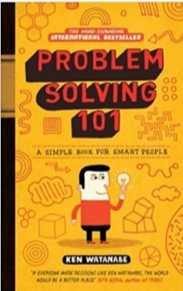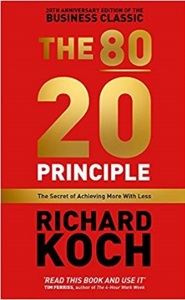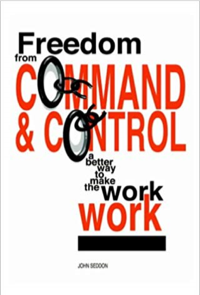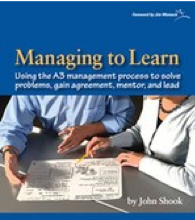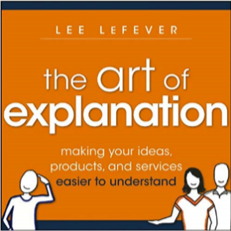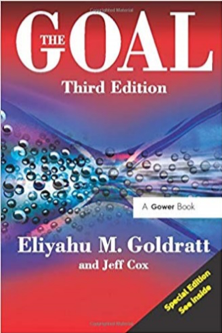Book Club
At the risk of being very 20th century, I wanted to have a bit of a book club. I’ve always loved reading to learn from people who been there and done it before me. It’s often the place I turn to when I get stuck. I’ve learnt many of the improvement approaches discussed on this blog through reading from the masters and then having a go myself. What follows is a list of the best books I’ve read on problem solving, process improvement and data visualisation and story-telling. They have all helped me to get better at what I do and are all on my bookshelf at home.
You should be able to click through from the thumbnails to find them on Amazon.
Problem Solving and Effectiveness
Problem Solving 101 by Ken Watanabe
Don’t be put-off or fooled by the quirky cartoon presentation of this book. It was originally written for Japanese school-children to teach them critical thinking skills, but has become a primer in clear thinking for problem solving.
Watanabe is an ex-McKinsey consultant and has done an excellent job of conveying the fundamentals of problem solving – from understanding the situation and getting specific about the problem, to understanding root cause and working out what to do about it.
It is the best introduction to problem-solving I have ever read.
The 80 / 20 Principle by Richard Koch
The 80 / 20 or pareto principle tells us that 80% of the results of something come from 20% of the causes. It’s something many people have heard of but few people really apply in their working lives day to day.
Want to understand why customers contact you and which processes you should work on improving first? Use the pareto principle.
Want to get rid of complexity and make your operation easier to manage? Yep, you’ve guessed it –the Pareto principle will be your guide. It is essential to improving any operation effectively and doing more with less.
Richard Koch didn’t invent it – he’s just explained how he uses it in his life. The 80/20 principle was first observed by Vilfredo Pareto, an 19th century Italian economist who was studying why wealth distribution was so skewed and why all the land was owned by a majority of rich people.
I am constantly amazed by how little it is used by many people in business and even big consulting firms. It is one of the most valuable concepts I have learnt.
Process Improvement
These aren’t the usual technical ‘how to’ books on process mapping, lean or six sigma, which I tend to find are very situation / industry specific. I’ve included these books because they helped me learn how to think about improving operations.
Freedom from Command and Control by John Seddon
John Seddon would have a fit if he saw his book under process improvement – he would see it as complete reinvention. The owner of Vanguard Consulting has applied Toyota’s “Systems Thinking” approach to Service operations. Although it can come across as a bit of a rant in places, there is a lot of content in here to make you think. From understanding why customers contact you and how much of that is caused by your own company’s failures to the impact your management system has on performance. If you run any large operation you should read this book.
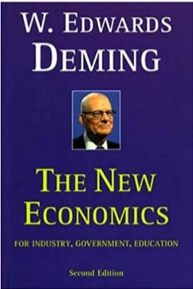
The New Economics – Deming
It was Deming who first had the insight that the way to improve any operation is to reduce variation and to continuously improve using a plan / do / check / act cycle. He viewed business as an interconnected system and was doing this stuff back in the 1950’s. He wasn’t listened to in his American homeland and so took his work and ideas to the Japanese. He was subsequently credited with contributing to the rise of the Japanese motor industry. I think it’s fair to say that Mr Deming’s talents lay in thinking about how to improve quality rather than writing so whilst the content is good, the style is a bit stilted and old-fashioned.
Managing to Learn – John Shook
Although this book is about something called A3 thinking – a Toyota problem solving method, its real value is in the excellent case-study based approach it adopts to illustrate how to use data to improve a process. The case study takes the form of a series of conversations between a new employee and an experienced manager mentor. I used to use excerpts from this book to help new starters on my team understand what operations analysis was all about.
Limited second hand availability on Amazon so expensive. Try Lean Enterprise Academy or googling it.
Understanding Variation – Donald Wheeler
Ok, so this one is a bit more of a ‘how to’ guide, but it’s the best short introduction to Control Charts I’ve found.
If you want to stop (yourself and your management team) reacting to every single peak and trough in performance or worse, miss an important signal and not act on it, then this is the book to help you learn how to distinguish between signals and noise.
Again, limited availability new on Amazon so expensive, but available second hand.
Data Visualisation and Story Telling
If you are going to recommend that an important process should be changed, you are going to have to influence whoever is in charge of that process to say yes. To do that you need to be good at telling stories with data so that those in charge can clearly understand the argument you’re making and are confident that it is supported by data. These books help with those two skills.
You can see examples of this approach in the case studies of previous work, here and here.
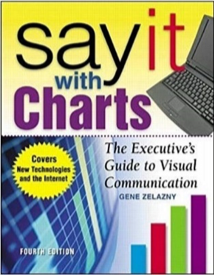
Say It with Charts – Gene Zelazny
As Business Intelligence and Analysis tools have become more powerful and capable of displaying just about any chart under the sun, it is more important than ever to remember that it doesn’t matter how good a chart looks if it can’t be quickly and easily understood.
This book is getting a bit old now. However, as a guide to understanding how to pick the right chart to communicate your data with impact, it is spot on and is a short and accessible read.
I made this required reading for all the analysts on my team. They thanked me later.
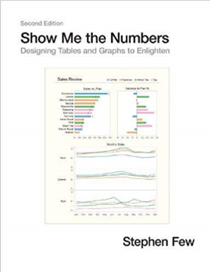
Show Me the Numbers – Stephen Few
Stephen Few is an expert in data presentation. This book is a reference guide rather than something to be read cover to cover. It contains lots of examples of both good and bad presentations of charts and tables.
If you want to know more about the principles of good data presentation and the science about how we perceive and interpret images and why that’s important to which charts you use then it’s all covered here in exhaustive detail.
Alternatively, if you’d like an animated overview of the main principles, check out the Data Looks Better Naked posts on the excellent Darkhorse Analytics blog for these couple of examples:
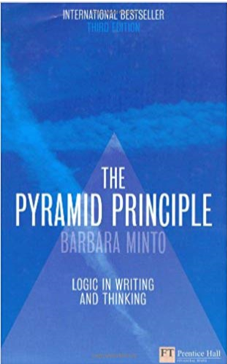
The Pyramid Principle – Barbara Minto
If you need to persuade anyone to back something you are recommending to them then they will need to be able to clearly and easily understand the argument you are making. This is an excellent book on how to sharpen up the logic and thinking in your report writing and presentations. It will change the way you read anything and help to improve your critical thinking.
The Art of Explanation – Lee LeFever
There is a process anyone can follow to help improve the quality of their explanations to communicate difficult concepts simply.
Lee LeFever runs a business creating simple explanations for technology companies like Intel and Dropbox.
Lee’s believes that explanation is a skill which can be built. Instead of me mangling his explanation on how he does that, here’s a 1 minute video if you’d like to learn more:
Inspiration
The Goal by Eli Goldratt
Engaging business novels are rarer than hen’s teeth. Who would have thought that anyone could write a successful novel about a guy trying to save his factory from closure by improving how it works?
Eli Goldratt introduced his Theory of Constraints model in this book about finding and managing the bottle-neck in a process. It is engagingly written and inspirational tale of how changing the way you look at the problem can be the key to solving it.


